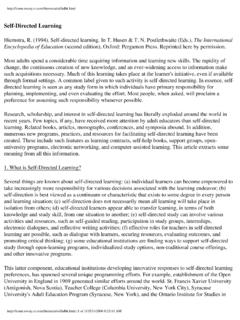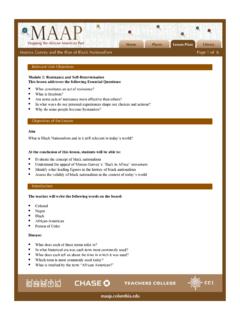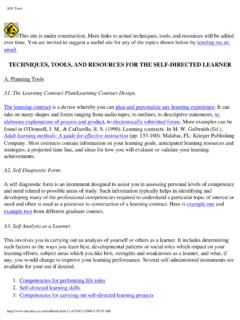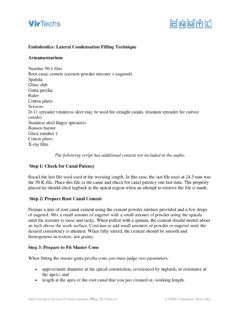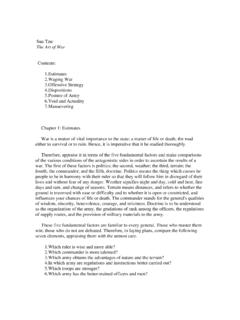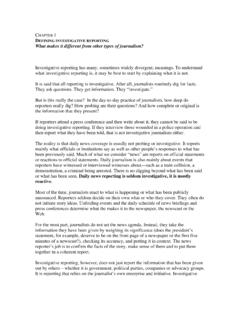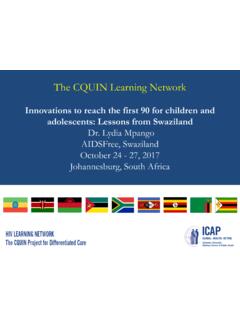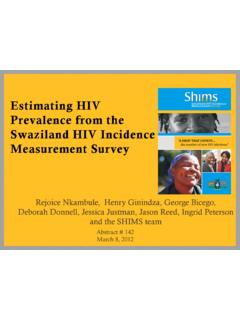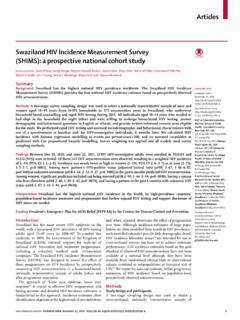Transcription of Swaziland, HIV and Option B+: What Can We Afford? …
1 This Teaching Note was written by Eric Smalley for the Case Consortium @ Columbia and the Mailman School of Public Health. Additional funding was provided by the Open Societies Foundations. (09/2014) swaziland , HIV and Option B+: What Can We Afford? Teaching Note Case Summary From 2007 through 2011, roughly a third of all adults and 56 percent of 25---- to 29----year----olds in the small, impoverished southern African nation of swaziland were HIV----positive, the highest rate in the world. Sub----Saharan Africa in general was hit far harder by the HIV----AIDS crisis than any other region in the world, with 15 million deaths and 15 million children orphaned by 2007. International organizations, led by the US President s Emergency Plan for AIDS Relief (PEPFAR) and the Global Fund to Fight AIDS, Tuberculosis and Malaria, committed several billion dollars to help the region deal with the crisis, but high drug prices and limited national healthcare systems proved stubborn challenges.
2 Stigmatization of people living with HIV, discrimination against women, and high rates of concurrent sexual partners also made it difficult to turn the tide of the epidemic. In October 2004, Dr. Velephi Okello was appointed swaziland s national antiretroviral therapy (ART) coordinator and technical advisor to the swaziland National AIDS Programme (SNAP) at the Ministry of Health. Faced with a shortage of doctors, Okello developed a decentralized HIV----AIDS treatment system run largely by nurses. Faced with a lack of data and in spite of minimal infrastructure and training, she rolled out a nation----wide medical records system. In spite of periodic drug supply problems, she developed and maintained treatment regimens that aimed for international best practices. She also delivered on her government s promise to take over funding for antiretroviral drugs, which had been funded for the most part by international organizations.
3 The case follows Okello s relationships with international players, in particular Columbia University s ICAP, a global health research and treatment organization that began work in swaziland in 2006. ICAP helped Okello bring antiretroviral therapy services to the country''s diverse, widely dispersed clinics. Much of the action in the case takes place in a 30----person Technical Working Group (TWG), chaired by Ministry of Health staff and including staff from ICAP and other international and local NGOs and donors. In April 2011, the TWG helped Okello create a treatment----as----prevention framework MSPH --14 --000 8 . 3 TN: swaziland , HIV and Option B+ 2 aimed at treating as many HIV----positive people as practical, including pregnant women, in order to reduce the odds of transmission and lower the viral load across the population.
4 The reader learns about updated WHO guidelines for using antiretroviral drugs to prevent mother----to----child transmission (MTCT) of HIV, dubbed Option B+, that called for treating all HIV---positive pregnant and breastfeeding women for life. The TWG debated whether Option B+ was appropriate for swaziland and, if so, whether the country could pull it off. Option B+ reduced MTCT in current and subsequent pregnancies, protected HIV----negative sex partners, and simplified antiretroviral treatment delivery. It was also a step toward treating all HIV----positive people in swaziland . At the same time it brought up an ethical question: should treating pregnant women be prioritized over treating other HIV----positive adults? Moreover, it was expensive. As tempting as the benefits of Option B+ were, swaziland s budget was already stretched thin.
5 Adopting the new guidelines would mean a 33----41 percent increase in the amount of antiretroviral drugs the country would need. There was also concern about whether swaziland s decentralized healthcare system could retain patients in treatment and maintain quality of care. If swaziland did move to Option B+, Okello and the TWG had to decide whether to roll it out across the country or take a phased approach. Teaching Objectives The HIV----AIDS crisis in swaziland and sub----Saharan Africa generally demands a smart, comprehensive and well----funded public health response. It requires a major commitment from national governments, sensitivity and consistency from international organizations, and an adaptable, evidence----based approach from health----care policymakers. This case raises for discussion issues of short----term costs versus long----term gains, cooperation and conflict among national and international organizations, international standards and best practices in varying socioeconomic and cultural contexts, and how to collect data and develop public health strategies in the face of severe resource constraints.
6 Specifically, this case gives the reader a window into the decision---making process of a national public health leader who must juggle all of these issues. Use the case to start discussion about the trade----offs that have to be weighed in stretching limited national resources to meet public health goals, particularly in handling crises. swaziland met its goal of funding all antiretroviral drug purchases; that achievement fulfilled the country s commitment to sustainability and strengthened its sovereignty. But is it realistic in the face of budget crises and drug supply challenges? Students should consider the challenges to a small, poor country of tackling an enormous public health crisis, including funding both treatment and prevention measures, accepting international aid while maintaining control of the process, and adapting international guidelines and best practices to the political, financial and cultural realities on the ground.
7 TN: swaziland , HIV and Option B+ 3 The case gives students the opportunity to discuss the role of international organizations in tackling public health crises in the developing world. Students should consider the advantages and challenges to national governments of accepting international aid. How important is a technical working group for coordinating efforts and sharing information among organizations and the government? What are implementing organizations like ICAP able to do that the government can t do for itself? What are the pros and cons of accepting money for antiretroviral drugs from international donors like Global Fund? Have students compare Option A, Option B and Option B+. Can swaziland afford the increased upfront costs of Option B+ in order to gain the long----term benefits?
8 Which is the bigger burden, expanding CD4 testing a challenge in rural clinics to reach more patients under Option B, or handling the more rapid increase in patient load under Option B+? Is treatment for life, as in Option B+, always desirable, or are there advantages to stopping treatment? Ask students to discuss the ethics of prioritizing treatment for pregnant and breast----feeding women. Is it right to give women priority over men, particularly when men in swaziland have poor health----seeking behaviors? Is it right to prioritize pregnant women over non----pregnant women, particularly when it could result in one woman continuing to receive treatment because she had been pregnant in the past, while a never----pregnant sister or neighbor with the same or worse HIV status goes without treatment? Have students consider the best way for swaziland to adopt Option B+, were the country to go that route.
9 How should swaziland make provision for the 33----41 percent increase in the quantity of drugs needed to treat all HIV----positive pregnant women for life? What should swaziland do to prepare for the increased patient load, particularly to ensure patients remain in treatment? Should the country roll out Option B+ across the board or take a phased approach? Class Plan Use this case in a course/class on public health policy, HIV----AIDS, Africa, multinational aid, medical ethics or evidence----based medicine. Pre----class. Help students prepare for class by assigning the following question: 1. Can swaziland afford to transition its HIV treatment strategy for pregnant women to the WHO----recommended Option B+? If not, why? If so, how? Instructors may find it useful to engage students ahead of class by asking them to post brief responses (no more than 250 words) to the above question in an online forum.
10 Writing short comments challenges students to distill their thoughts and express them succinctly. The instructor can use the students work both to craft talking points ahead of class and to identify particular students to call upon during the discussion. TN: swaziland , HIV and Option B+ 4 In----class questions: The homework assignment is a useful starting point for preliminary discussion, after which the instructor could pose any of the following questions to promote an 80---90 minute discussion. The choice of questions will be determined by what the instructor would like the students to learn from the class discussion. In general, choosing to discuss three or four questions in some depth is preferable to trying to cover them all. a) How does the continual risk of drug shortages affect swaziland s ability to deal with the HIV----AIDS crisis?
